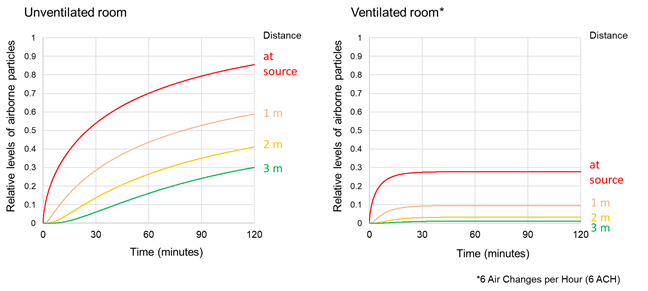COVID can be airborne, in floating “aerosol” particles. We know how these particles move, and how long they stay in the air. What does this mean for minimising risk? TL;DR: ventilate rooms to stop aerosol levels building up; masks and distancing still help but 2m not magic bullet
Aerosol particles are given off especially when someone is talking, without a mask, like a smoker giving off smoke. https://twitter.com/MWStory/status/1309561305616076800?s=20">https://twitter.com/MWStory/s... If that person has COVID, and someone else breathes in their aerosol, that can pass on COVID infection.
Indoors, over time, the aerosol levels build up and the particles spread further from that person, so everyone else is breathing in more aerosol, meaning more risk of catching COVID. Superspreading events have shown that the particles can spread further than 2m.
Having many people together, talking or singing, without masks, in unventilated closed room, for several hours, is the least safe, and a recipe for superspreading events. Best way to stay safe is to meet outdoors, distanced; airborne particles are quickly diluted by fresh air.
It is not possible to be completely safe meeting indoors, but there are a few different things that each help, and taken together can make it a lot safer:
This basic simulation shows potentially COVID-bearing aerosol levels changing with time, and distancing, in well-ventilated (doors / windows open) vs unventilated rooms (doors / windows closed). Details at end of thread. What do the graphs mean for meeting in pubs and houses?
Ventilation helps. Getting fresh air in and old air out makes a big difference, stopping levels from building up.
In an unventilated room in a party or pub, where people have been talking together for hours, levels will be high. Particles will have spread throughout the room, so distancing won’t help.
Mask-wearing cuts COVID transmission by at least 80% https://www.nature.com/articles/d41586-020-02801-8.">https://www.nature.com/articles/... So levels will all be 5 x less. But the particles will have had just as much time to spread, so again, distancing won’t help after a long time in an unventilated room. Important for classrooms.
The graphs show “6 air changes / hour” ventilation. This is typical regulation for a modern office. https://qz.com/1907977/how-to-check-air-ventilation-to-prevent-covid-19-spread/">https://qz.com/1907977/h... In a house, you can open windows, ideally a window / door open at each end to allow a draft. https://www.theguardian.com/world/2020/sep/30/germans-embrace-fresh-air-to-ward-off-coronavirus">https://www.theguardian.com/world/202...
A rough way of checking: if you switch off the heating and open the window(s), the temperature should drop to half of its final (outdoor) level within 6 minutes for the 6 ACH ventilation in the graphs.
If you can’t ventilate the room, then keeping your meetings short (<15 minutes) AND keeping distance (>2m) AND wearing masks is safer. Also good if you can ventilate between people being in the room.
Is heating rooms with open windows wasting energy and bad for the environment? Sure; it’s a trade-off. New York put in steam radiators to keep windows open through winter during the 1918 flu pandemic. https://www.bloomberg.com/news/articles/2020-08-05/the-curious-history-of-steam-heat-and-pandemics">https://www.bloomberg.com/news/arti... Environmental effects can be mitigated...
…by getting used to wearing more layers when socialising indoors, and by switching off heating in unoccupied rooms, or if everyone in the house is out.
Calculation details: the model assumes a constant rate of aerosol production. Aerosols assumed to disappear with a half-life of 1 hour https://www.nejm.org/doi/10.1056/NEJMc2004973">https://www.nejm.org/doi/10.10... and diffuse with an effective diffusion coefficient of 0.0016 m2/s https://www.medrxiv.org/content/medrxiv/early/2020/09/30/2020.09.30.20199943.full.pdf">https://www.medrxiv.org/content/m...
Best people to follow to find out more about aerosols, COVID, and ventilation: @CathNoakes @linseymarr @ShellyMBoulder @jljcolorado

 Read on Twitter
Read on Twitter


